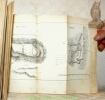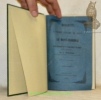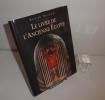-
Type
Book (27437)
Disk (1)
Engraving (1)
Magazine (1074)
Old papers (2)
Photographs (2)
Reprint (4)
-
Latest
Last 24h (2)
Last 3 days (3)
Last month (1868)
Last week (11)
-
Language
Chinese (1)
Dutch (20)
English (50)
French (28411)
German (16)
Italian (15)
Latin (4)
Portuguese (1)
Spanish (3)
-
Century
16th (3)
17th (14)
18th (58)
19th (1602)
20th (12197)
21st (1317)
-
Countries
Belgium (3987)
Brazil (1)
Canada (6)
China (15)
Côte d'Ivoire (79)
Denmark (486)
France (19732)
Greece (7)
Netherlands (1743)
Switzerland (2465)
-
Syndicate
ALAC (6)
CLAM (41)
ILAB (8784)
NVVA (1082)
SLACES (1082)
SLAM (7143)
SNCAO (71)
Bernissart il y a 125.000.000 d'années. Le règne des iguanodons.
Bruxelles, IR SC N B (Les richesses paléontologiques de Belgique), sans date, in 8°, reliure souple de l'éditeur, couverture illustrée conservée, 87 pages ; nombreuses illustrations et figures, en noir et en couleurs.
...................... Photos sur demande ..........................


Phone number : 04 77 32 63 69
Notice sur des médailles romaines découvertes au pied de la montagne de Crussol, dans la commune de Saint-Peray (Ardèche).
Valence, Société départementale d'Archéologie et de Statistique de la Drôme, 1837. broché, sans couverture. in-8 de 10 pages, paginées 53 à 62, sur papier vergé.
Phone number : 06 80 15 77 01
HISTOIRE D'ALEXANDRE LE GRAND - NOUVELLE EDITION - TOME PREMIER.
CHEZ B.CORMON ET BLANC. 1810. In-12. Relié plein cuir. Etat d'usage, Coins frottés, Coiffe en tête abîmée, Intérieur frais. 389 pages - un tampon sur la page de titre - contre plats jaspés - auteur, tomaison, filets dorés sur le dos - coiffe en tête abîmée.. . . . Classification Dewey : 930.1-Archéologie
Traduite par M.Beauzée - Enrichie des supplémens de Freinshémius et corrigée d'après l'édition de Min-Ellius. Classification Dewey : 930.1-Archéologie
Histoire de la réunion de l’ancien Evêché de Bâle au canton de Berne 1813 à 1818. Histoire de la Révolution dans le Jura bernois 1830 à 1831.
Delémont, Imprimerie J. Boéchat 1882, 210x140mm, VII- 211pages, broché. brochage moderne, couverture d’origine collée sur les plats, tranches rognées, bon état.
Pour un paiement via PayPal, veuillez nous en faire la demande et nous vous enverrons une facture PayPal
Monuments de l’ancien Evêché de Bâle. Le Mont-Terrible avec Notice historique sur les établissements des romains dans le Jura bernois.
Porrentruy, Imprimerie et Lithographie V. Michel 1862, 210x140mm, VIII- 252pages, broché. brochage moderne, couverture d’origine collée sur les plats, tranches rognées, quelques petites rousseurs, autrement bon état.
12 planches lithographiques en partie dépliantes, Pour un paiement via PayPal, veuillez nous en faire la demande et nous vous enverrons une facture PayPal
Monuments de l’ancien Evêché de Bâle. Le Mont-Terrible avec Notice historique sur les établissements des romains dans le Jura bernois.
Porrentruy, Imprimerie et Lithographie V. Michel 1862, 210x140mm, VIII- 252pages, reliure skyvertex verte avec titre et filets dorés au dos.Couverture supérieure conservée et restaurée. Bel exemplaire.
12 planches lithographiques en partie dépliantes, Pour un paiement via PayPal, veuillez nous en faire la demande et nous vous enverrons une facture PayPal
Découverte d'une officine de potiers gallo-romains à Lubié près Lapalisse (Allier).
Moulins, Desrosiers, 1881 ; in-8, broché. 108pp.-1 planche hors-texte. Couverture bleue, premier plat remonté. déchirure sans manque et tpatite tâche sur la couverture.
Tiré-à-part de Bulletin de la Société d'Emulation du Bourbonnais. Envoi autographe d' A. Bertrand. Histoire de Lubié, circonstances de la découverte, inventaire descriptif des objets trouvés. La planche reproduit les noms des potiers apparaissant sur les vestiges. Lubié (ou Lubillé) était le site primitif de peuplement du village de Lapalisse, et restat jusqu'à la Révolution le chef lieu d'une paroisse avec église et cimetière.
Le livre de l'ancienne Égypte, traduit de l'anglais par Denis-Armand Canal. BRITISH MUSEUM. Philippe Lebaud. 1995.
1 volume in-4° relié plein cartonnage sous jaquette illustrée, 252 p. + illustrations. Très bon état, marque de propriété en garde.
Phone number : 06.31.29.75.65
Le Christ cet inconnu - La vraie figure du Christ d'après les dernières découvertes archéologiques et les plus récentes études exégétiques, philologiques et littéraires [2 vol.]
Bruxelles/Paris, Vanderlinden/ Alsatia 1947 2 tomes (complet): liv, 365pp. avec ills. + 10pp. ills. hors-texte & 404pp. avec ills., brochures originales, 24cm., bel état, poids: 1.5kg., R16221
Compte-Rendu des travaux de la Commission des Monuments Historiques, du Département de la Gironde, pendant l'année 1847 - 48. Rapport présenté au Préfet de la Gironde. Eglise Saint-André de Bordeaux.
A LA LIBRAIRIE ARCHEOLOGIQUE DE VICTOR DIDRON. 1848. In-12. Broché. Bon état, Livré sans Couverture, Dos satisfaisant, Intérieur frais. 46 pages + 16 planches illustrées en noir et blanc.. . . . Classification Dewey : 930.1-Archéologie
Classification Dewey : 930.1-Archéologie
[Imprimerie de Durand Librairie Archéologique de Didron] - RABANIS, M. ; L. de LAMOTHE ; DOSQUET, M. ; DROUYN, Léo ; DUTAUZIN ; LAPOUYADE
Reference : 54806
(1850)
Compte-Rendu des Travaux de la Commission des Monuments Historiques du Département de la Gironde, pendant l'Année 1849-50 [ Avec : ] Compte-Rendu des Travaux de la Commission des Monuments Historiques du Département de la Gironde, pendant l'Année 1850-51 [ Avec : ] Compte-Rendu des Travaux de la Commission des Monuments Historiques du Département de la Gironde, pendant l'Année 1851-52 [ Avec : ] Compte-Rendu des Travaux de la Commission des Monuments Historiques du Département de la Gironde, pendant l'Année 1852-53 [ Edition originale ]
4 fascicules en 1 vol. in-8 reliure demi-percaline bordeaux, Librairie Archéologique de Didron, Paris, 1850-1853, 73-49-68-80 pp. et nombreuses planches hors texte.Rappel du titre complet : Compte-Rendu des Travaux de la Commission des Monuments Historiques du Département de la Gironde, pendant l'Année 1849-50 [ Avec : ] Compte-Rendu des Travaux de la Commission des Monuments Historiques du Département de la Gironde, pendant l'Année 1850-51 [ Avec : ] Compte-Rendu des Travaux de la Commission des Monuments Historiques du Département de la Gironde, pendant l'Année 1851-52 [ Avec : ] Compte-Rendu des Travaux de la Commission des Monuments Historiques du Département de la Gironde, pendant l'Année 1852-53 [ Edition originale ]
Bel exemplaire réunissant 4 de ces rares comptes-rendus, richement illustrés de nombreux gravures hors-texte. Tous les grands monuments de la Gironde sont passés en revue (pour la seule première livraison de ce volume, on trouvera notamment des études sur le campement gallo-romain de Saint-Médard en Jalles, les ruines de La Sauve, l'église de Pertignas, de Lafosse, d'Uzeste, le clocher de Saint Emilion, le château de Brugnac, le retable de la chapelle du Saint-Sépulcre à Saint-Michel, l'ancien jubé de Saint-André, le musée des antiques de Bordeaux, la mosaïque de Langon, monnaies et crypte à La réole, médailles d'or de Belin, les églises de Cazelles et Marcamps, le château d'Olivier à Léognan, la chronologie des maires de Bordeaux, l'ancien collège de Guienne, l'hygiène publique à Bordeaux au Moyen-Age, les privilièges de Mimisan et l'Ancien domaine de la Ville de Bordeaux !). Bel exemplaire (qq. annotations au crayon, très bon état par ailleurs). Voir par ailleurs dans notre catalogue nos autres recueils pour les années 1845 à 1849 et 1853 à 1855
[Imprimerie de Durand Librairie Archéologique de Didron] - RABANIS, M. ; L. de LAMOTHE ; DROUYN, Léo ; DUTAUZIN ; LAPOUYADE
Reference : 54805
(1846)
Compte-Rendu des Travaux de la Commission des Monuments Historiques du Département de la Gironde, pendant l'Année 1845-46 [ Avec : ] Compte-Rendu des Travaux de la Commission des Monuments Historiques du Département de la Gironde, pendant l'Année 1846-47 [ Avec : ] Compte-Rendu des Travaux de la Commission des Monuments Historiques du Département de la Gironde, pendant l'Année 1847-48 [ Avec : ] Compte-Rendu des Travaux de la Commission des Monuments Historiques du Département de la Gironde, pendant l'Année 1848-49 [ Edition originale ]
4 fascicules en 1 vol. in-8 reliure demi-percaline bordeaux, Imprimerie de Durand, Successeur de Lavigne Jeune, Bordeaux, 1846, Librairie Archéologique de Didron, Paris, 1847, 1848, 1849, 99-87-46-72 pp. et nombreuses planches hors texte.Rappel du titre complet : Compte-Rendu des Travaux de la Commission des Monuments Historiques du Département de la Gironde, pendant l'Année 1845-46 [ Avec : ] Compte-Rendu des Travaux de la Commission des Monuments Historiques du Département de la Gironde, pendant l'Année 1846-47 [ Avec : ] Compte-Rendu des Travaux de la Commission des Monuments Historiques du Département de la Gironde, pendant l'Année 1847-48 [ Avec : ] Compte-Rendu des Travaux de la Commission des Monuments Historiques du Département de la Gironde, pendant l'Année 1848-49 [ Edition originale ]
Bel exemplaire réunissant 4 de ces rares comptes-rendus, richement illustrés de nombreux gravures in et hors texte. Tous les grands monuments de la Gironde sont passés en revue (pour ces livraisons, on trouvera des études sur Saint-Seurin, le château de La Brède, le château de Puypaulin, les maisons anciennes de Bordeaux, etc. etc. (qq. annotations au crayon, très bon état par ailleurs). Voir par ailleurs dans notre catalogue nos autres recueils pour les années 1849 à 1853 et 1853 à 1855
Jaurès et son assassin
,Paris, Editions du Centurion 1967, 238 pp., 1 vol. in 8 br. couverture illustrée.
Der Limes - Die Deutsche Limes-Strasse vom Rhein bis zur Donau
Darmstadt, Wissenschaftliche Buchgesellschaft 2000 160pp.richly ill., cart., dustwrapper, 30cm., VG
Le prieuré royal de Haute-Bruyère de l'ordre de Fontevrault.
Rambouillet, Société Archéologique, 1948 ; in-8, broché. 121pp.-1f. - 5 planches hors-texte. Bon état, couverture légèrement défraîchie.
Edition originale tirée à 500 exemplaires sur vélin bouffant.
Habitations lacustres de la Savoie. 2ème mémoire qui a obtenu le prix d'archéologie au Concours des Sociétés savantes en 1866. Album.
A Chambéry, Académie impériale des sciences, belles-lettres et arts de la Savoie, Lithographie Jh. Perrin, 1867. In-folio, demi-chagrin brun à coins, dos (un peu frotté) à 5 nerfs avec titre doré. Rousseurs.
L'album se compose d'une page de titre avec une jolie vignette de Champod, suivie de 17 planches lithographiées présantant des objets lacustres. Peu courant.
Habitations lacustres de la Savoie. ALBUM.
Chambéry Bib. Charpentier / E. Fasquelle 1864 Un volume in folio (26,5 x 33cm), broché, non paginé, sous couverture imprimée. (couvertures brunies avec des petites fentes en bordure, rares rousseurs, fine bande brune en marge des planches). Plan dépliant représentant le lac du Bourget. 16 lithographies à pleine page représentant des objets archéologiques. Hommage signé de l'auteur en haut de couverture.
Civilisations et archéologie de la Grèce préhellénique: Crète, Mycène, Troie, Chypre
Rocher,1993, 819 pp., relié, jaquette un peu défraîchie et décolorée sur le dos, état correct
Phone number : 0033 (0)1 42 23 30 39
Civilisation et archéologie de la grèce préhellenique
Editions du Rocher 1993 In-8 relié 25 cm sur 16,5. 820 pages. Très bon état d’occasion.
Très bon état d’occasion
Civilisations et archéologie de la Grèce préhellenique. Crète, Mycènes, Troie, Chypre
Editions du Rocher Cartonné avec jaquette 1993 in-4 (25*16.5), cartonné avec jaquette, 819pp., illustrations, cartes et tableaux, bibliographie abondante ; jaquette légèrement usée, très bon état Livraison a domicile (La Poste) ou en Mondial Relay sur simple demande.
DICTIONNAIRE DE L'ARCHÉOLOGIE
Paris Robert Laffont - Bouquins 1983 in 8 (19,5x13) 1 fort volume broché, couverture illustrée, III et 1052 pages, avec des figures et plans en noir et blanc dans le texte. Texte sur sur deux colonnes. Avec la collaboration de Louis Frédéric. Collection Bouquins. Bel exemplaire ( Photographies sur demande / We can send pictures of this book on simple request )
Très bon Broché
L'Egypte
,Paris, Nathan 1985, 192 pp., 1 vol. in 4 relié plein toile verte éditeur avec jaquette illustrée, très petite tache aux 3 premiers feuillets, nombreuses illustrations in et hors-texte en noir et blanc et en couleurs.
Les Matins de la France. Du paléolithique à la fin de la Gaule romaine.
Bartillat, Paris, 1999. Un volume in-8 dos collé, couverture blanche illustrée, 536 pages. Bel état.
La librairie est ouverte du mardi au samedi de 9h30 à 12h30 et de 13h30 à 19h00. Commandes par courriel ou téléphone. Envoi rapide, emballage soigné.
Aux Sources de l'Archéologie.
LAFFONT Robert. Avril 1980. In-8. Cartonnage d'éditeurs. Très bon état, Couv. fraîche, Dos satisfaisant, Intérieur frais. 301 pages. Nombreuses illustrations et photos en noir et blanc, dans le texte et en hors-texte. Quelques planches en couleurs.. . . . Classification Dewey : 930.1-Archéologie
"Collection ""La Grande Aventure de l'Archéologie"" dirigée par Guy Rachet. Classification Dewey : 930.1-Archéologie"
Civilisations Enigmatiques.
LAFFONT Robert. Sept. 1981. In-8. Cartonnage d'éditeurs. Bon état, Couv. convenable, Dos satisfaisant, Intérieur frais. 303pages. Nombreuses illustrations et photos en noir et blanc, dans le texte et en hors-texte. Quelques planches en couleurs.. . . . Classification Dewey : 930.1-Archéologie
"Collection ""La Grande Aventure de l'Archéologie"" dirigée par Guy Rachet. Classification Dewey : 930.1-Archéologie"
 Write to the booksellers
Write to the booksellers







![Compte-Rendu des Travaux de la Commission des Monuments Historiques du Département de la Gironde, pendant l'Année 1849-50 [ Avec : ] Compte-Rendu des ...](https://static.livre-rare-book.com/pictures/CDL/54806_thumb.jpg)
![Compte-Rendu des Travaux de la Commission des Monuments Historiques du Département de la Gironde, pendant l'Année 1849-50 [ Avec : ] Compte-Rendu des ...](https://static.livre-rare-book.com/pictures/CDL/54806_2_thumb.jpg)
![Compte-Rendu des Travaux de la Commission des Monuments Historiques du Département de la Gironde, pendant l'Année 1849-50 [ Avec : ] Compte-Rendu des ...](https://static.livre-rare-book.com/pictures/CDL/54806_3_thumb.jpg)
![Compte-Rendu des Travaux de la Commission des Monuments Historiques du Département de la Gironde, pendant l'Année 1845-46 [ Avec : ] Compte-Rendu des ...](https://static.livre-rare-book.com/pictures/CDL/54805_thumb.jpg)
![Compte-Rendu des Travaux de la Commission des Monuments Historiques du Département de la Gironde, pendant l'Année 1845-46 [ Avec : ] Compte-Rendu des ...](https://static.livre-rare-book.com/pictures/CDL/54805_2_thumb.jpg)
![Compte-Rendu des Travaux de la Commission des Monuments Historiques du Département de la Gironde, pendant l'Année 1845-46 [ Avec : ] Compte-Rendu des ...](https://static.livre-rare-book.com/pictures/CDL/54805_3_thumb.jpg)







